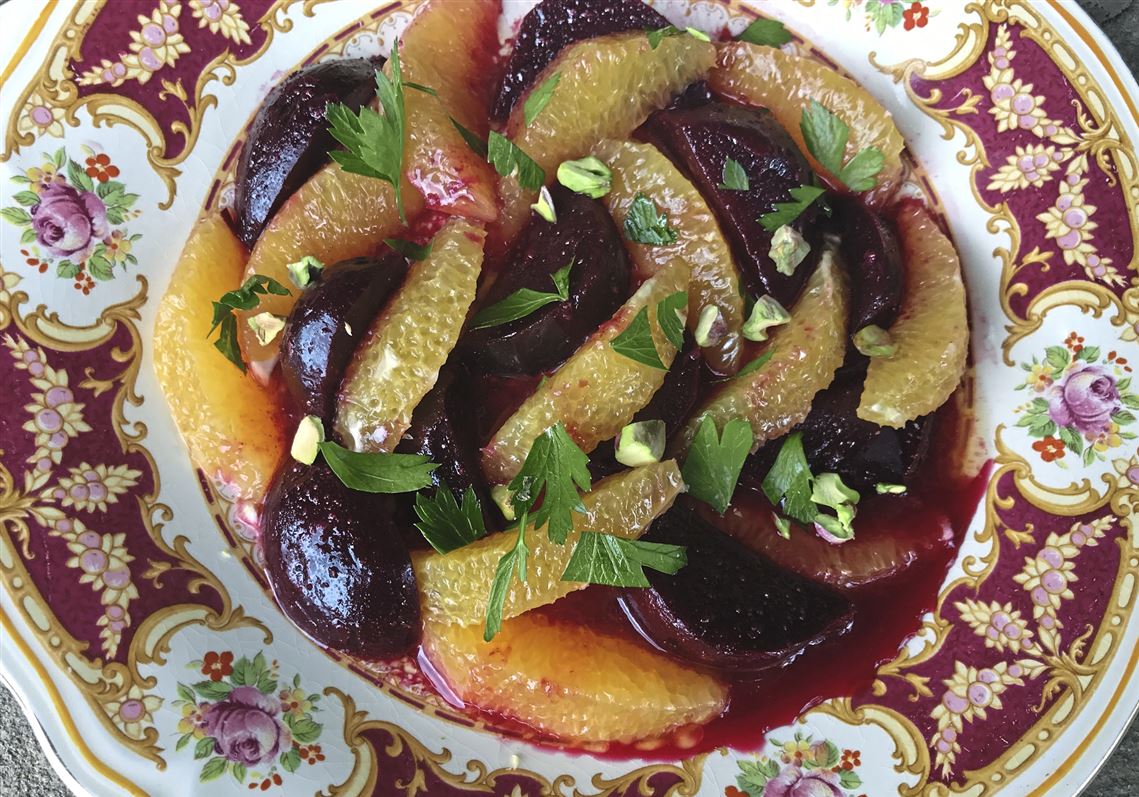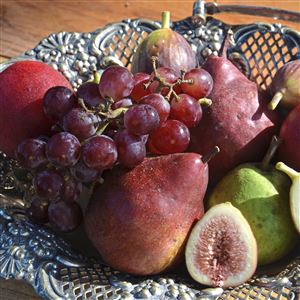The Jewish New Year, Rosh Hashana, is a joyous holiday. “It’s also a time of inner reflection,” said Rabbi Barbara Symons of the reform Temple David in Monroeville. “We think of the previous year and consider how we can be better people as we go into the next year.”
Rosh Hashana, which begins at sundown on Sept. 20, is known as the Head of the Year, launching 10 days of repentance and ending in Yom Kippur, the Day of Atonement.
While on Yom Kippur, Jews fast, on Rosh Hashana there is feasting, relishing the sweet flavors of the harvest.
A lovely, ancient custom is to eat a new fruit, one that you have not yet sampled this year. Pomegranates are in season, their numerous seeds symbolizing fertility and good deeds. Other new fruits are figs, quinces, dates, prune-plums and concord grapes.
Rabbi Symons said that eating a new fruit is a way of marking the new year. “We do this at other times as well such as during the New Year for Trees. Then we taste different foods from the land of Israel,” she said.
At Rosh Hashana, the challah is round, symbolizing the cycle of life. It’s also sweeter and perhaps studded with raisins. After it’s blessed, pieces of the bread are dipped in honey. Apple slices are dipped in honey also. Try a new apple variety, maybe, for a new fruit. Before eating them, a blessing is recited: “May it be your will to renew for us a good and sweet year.”
Many times, holiday meals are heavy with meat and roasted poultry. This year, why not revel in the vegetables and fruits of the season. Or add the following vibrant and colorful dishes to your feast.
From Joan Nathan’s new book on global Jewish cooking, “King Solomon’s Table” comes two bright salads — one with beets and oranges and the other with apples and pomegranates. Noting that beets are symbolic for the holiday, she writes, that “you are supposed to serve at least seven vegetables for the new year, including beets,” according to ancient rabbinical commentary.
She has a brilliant riff on tabbouleh. It is prepared not with bulgur and cucumbers, but instead is a fall version with apples and pomegranates, and is based on a dish from chef/owner Michael Solomonov of Zahav in Philadelphia.
I wanted to make all the recipes in Leah Koenig’s new “Little Book of Jewish Appetizers.” She takes a concept and adds spin and pizazz to it. Ms. Koenig writes that she considers certain Jewish foods “celebrations” and “events.”
In Green Matbucha, eggplant stars in the usually tomato-heavy North African dish that can be served as a salad or dip. It has heat plus lots of za’atar, a blend of thyme, sumac, Syrian oregano and sesame seeds.
Ms. Koenig’s Sweet Potato Hummus stops the show as a clever twist on the classic. It “retains the dip’s structural integrity — chickpeas, tahini, garlic — while elevating its flavor profile,” she writes.
Here’s to a delicious and sweet new year!
Miriam Rubin: mrubin@gmail.com or on Twitter @mmmrubin.
Moroccan Beet and Orange Salad
PG tested
Some people avoid eating nuts during the holiday. If that’s your custom, simply omit them.
6 to 8 medium beets, scrubbed
2 tablespoons vegetable oil
2 to 3 navel oranges
1/4 cup extra-virgin olive oil
1 to 2 tablespoons fresh lemon juice
1 small garlic clove, grated
1 teaspoon ground cumin, or to taste
Kosher salt and freshly ground black pepper
1/2 bunch flat-leaf parsley, chopped
2 tablespoons chopped green pistachios
Preheat oven to 350 degrees. Rub beets with vegetable oil; wrap each in foil and place on rimmed baking sheet. Bake 1 hour or more, until tender when poked with fork. Cool, peel and cut into wedges.
Cut off tops and bottoms of oranges. Slice off peel and white pith. Working over a bowl, cut in between membranes to extract segments, dropping them into the bowl. Squeeze over the juice from membranes. Cover and refrigerate.
In medium bowl, with fork, blend olive oil, lemon juice, garlic, cumin and salt and pepper to taste. Toss in beets. Let sit a few hours at room temperature. Before serving, add orange segments and some of their juice. Sprinkle with parsley and pistachios.
Makes 6 to 8 servings.
— Adapted from “King Solomon’s Table: A Culinary Exploration of Jewish Cooking From Around the World” by Joan Nathan. (Knopf; April 4, 2017; $35)
Tabbouleh With Apples, Walnuts and Pomegranates
PG tested
Urfa pepper is a chili from Turkey, used like black pepper. Since I didn’t have it, I used smoked paprika with a pinch of cayenne.
2 Pink Lady or Gala apples, unpeeled, cut into small cubes
1 bunch flat-leaf parsley, finely chopped
1/2 cup pomegranate seeds
1/4 cup chopped red onion
1½ to 2 teaspoons ground Urfa pepper or smoked paprika, plus pinch cayenne
1 to 2 tablespoons honey
1/4 cup fresh lemon juice
1/4 cup extra-virgin olive oil
Kosher salt, divided, to taste
1/2 cup walnuts
Cabbage leaves, romaine lettuce, endive leaves or fresh grape leaves for scooping up
In medium bowl, mix apples, parsley, pomegranate and red onion. Stir in Urfa pepper or paprika, honey, lemon juice and oil; season with salt and mix well.
In small dry skillet over medium heat, stir walnuts until toasted, about 3 minutes. Remove from heat; add pinch of salt and mash on board with flat side of chef’s knife or in mortar and pestle until coarsely chopped. Stir into fruit tabbouleh.
Serve with cabbage, romaine, endive or grape leaves for scooping.
Makes 6 to 8 servings.
— Adapted from “King Solomon’s Table: A Culinary Exploration of Jewish Cooking From Around the World” by Joan Nathan. (Knopf; April 4, 2017; $35)
Green Matbucha
PG tested
The Middle Eastern dish can be served as a dip with challah or crackers, or as a cooked salad.
1/4 cup plus 2 tablespoons extra-virgin olive oil, divided
1 medium onion, chopped
3 cups 1/2-inch cubes peeled eggplant
1 medium green bell pepper, cut into ½-inch pieces
1 jalapeno, seeded and minced
1 tablespoon sugar
Kosher salt, divided
6 garlic cloves, minced
2 teaspoons za’atar, plus more for serving
½ teaspoon onion powder
½ teaspoon (or more) crushed red pepper
1 (14.5-ounce) can diced tomatoes, undrained, or 2 cups diced fresh tomatoes
2 cups packed basil leaves
1 cup packed mint leaves
Freshly ground black pepper
In large heavy saucepan over medium heat, warm ¼ cup oil. Add onion, eggplant, bell pepper, jalapeno, sugar and big pinch salt. Cook, stirring occasionally, until softened, 12 to 15 minutes. Add garlic, za’atar, onion powder and crushed red pepper. Cook, stirring, until fragrant, 1 to 2 minutes.
Add tomatoes and juices; bring to simmer. Reduce heat to low and cook, partially covered, stirring often, until vegetables are very tender, about 10 minutes, mashing with potato masher halfway though cooking.
Meanwhile, put basil, mint, remaining 2 tablespoons oil, 1 tablespoon water and pinch salt in food processor. Pulse, scraping sides, until finely chopped.
Stir herb mixture into eggplant; cook, uncovered, about 5 minutes, until thickened. Season with salt, pepper and more crushed red pepper, if desired. Serve warm or room temperature, sprinkled with more za’atar. Keeps in refrigerator up to 3 days.
Makes 8 servings.
— Adapted from “Little Book of Jewish Appetizers” by Lisa Koenig. (Chronicle, Aug. 8, 2017; $18.95)
Smoky Sweet Potato Hummus
PG tested
Up the cumin or smoked paprika if you like. Serve with warm pita triangles, crackers or vegetable dippers.
1 large sweet potato, about 1 pound
1/3 cup tahini
1/3 cup extra-virgin olive oil, plus more for drizzling
1 (15-ounce) can chickpeas, drained, liquid reserved
1 large garlic clove, chopped
3 tablespoons fresh lemon juice, or more to taste
1/2 teaspoon smoked paprika
1/2 teaspoon ground cumin
1/2 teaspoon kosher salt
Chopped fresh cilantro, for serving
Preheat oven to 400 degrees.
Pierce sweet potato with tip of knife and place on small baking sheet. Bake until completely tender, about 1 hour. Let cool, then remove and discard skin.
Put sweet potato, tahini, oil, drained chickpeas (reserve liquid), garlic, lemon juice, paprika, cumin and salt in food processor. Process to a thick paste, scraping sides.
With machine running, slowly pour in 1/4 to 1/3 cup reserved chickpea liquid. Continue processing until smooth and creamy. Add more lemon juice, salt or spice, if needed. Transfer to a shallow bowl or plate, drizzle with olive oil, sprinkle with cilantro. Keeps in refrigerator up to 1 week.
Makes 6 to 8 servings.
— Adapted from “Little Book of Jewish Appetizers” by Leah Koenig. (Chronicle, Aug. 8, 2017; $18.95)
Correction Sept. 13, 2017: An earlier version gave the wrong date for Rosh Hashana.
First Published: September 13, 2017, 4:00 a.m.



















